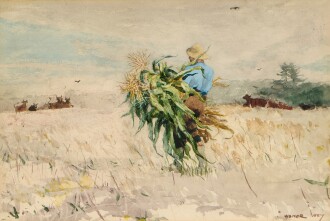Works by Winslow Homer at Sotheby's
Winslow Homer Biography
American printmaker and painter Winslow Homer was a widely revered artist of the 19th century, and his oeuvre continues to captivate viewers today. His realist works present scenes from the Civil War, fishing expeditions, and moments of everyday life in the United States, all genres that helped work to establish a distinctly American form of realism to which subsequent artists turned in the late 20th century. The precision of his early paintings gradually loosened in his later works, providing innovations in prototypical abstraction through rich, chromatic drama and the awareness of the spontaneity of vision.
Born in 1836 in Boston, Massachusetts, Homer briefly apprenticed with lithographer J.H. Bufford, but was largely self-taught. In his early 20s, he began working as a freelance illustrator for several magazines, including Ballou’s Pictorial and Harper’s Weekly. He was naturally adept at quickly building a visual language with sharp lines and simplified forms. In 1859, he moved to New York where he opened a studio in the Tenth Street Studio Building. He began producing impressive oil paintings until Harper’s Weekly sent him to document the front lines of the Civil War, where he sketched the realities of life as a soldier – both during battle and in quiet moments at camp. Following a ten-month stay in Paris after the war’s end, Homer began to experiment with watercolor as well as a broader range of subject matter, including leisurely scenes of contemporary life. After another visit to Europe in 1881, where he primarily travelled in England, Homer turned to scenes of labor on the docks and at sea – both subjects he would later become closely associated. His mature works, which he produced while in relative solitude in Prouts Neck, Maine, were among his most experimental, and exhibited an overall increase in gestural application of paint and staunch contrasts of dramatic color.
Many of the homes in which Homer lived across New England have been preserved as museums in commemoration of his life and career. His works can be found in the Musée d’Orsay, Paris, the National Gallery of Art, Washington, DC, the Metropolitan Museum of Art, New York, and many other major institutions across the United States.
Read Less












